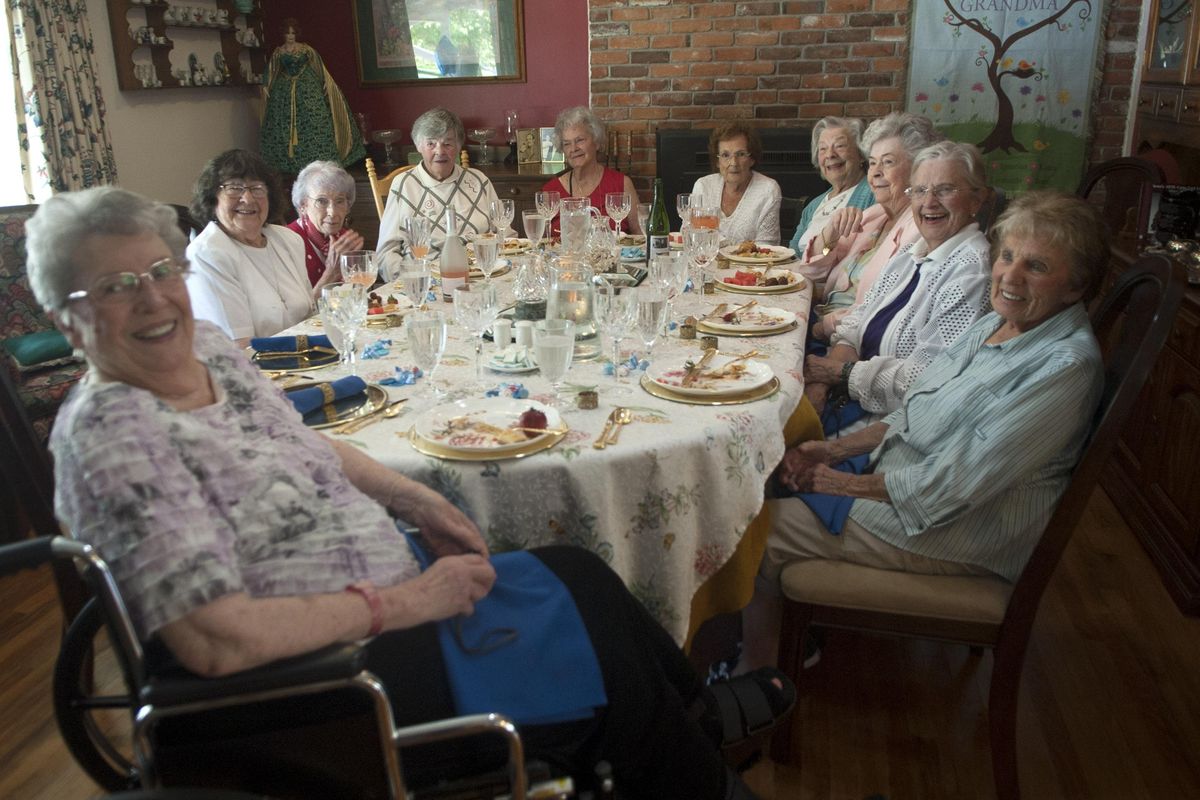Clarksville: Marycliff Class of ’47 celebrates with great memories

Never been much for high school reunions.
Heck, I don’t even pay attention to my own when the rah-rah rolls ’round.
But life is long and interesting and, as it’s been said unto death so many times before, there are exceptions to be made for practically everything.
One of those took place on a sunny Monday last week. That’s when I accepted an invitation to celebrate with members of the Marycliff Class of ’47.
No. That’s not a typo.
The 10 lovely women I joined for lunch in an immaculate home on Spokane’s South Hill received their high school diplomas from Marycliff, an all-girls Catholic high school, 70 years ago.
Corrine Chasse, Betty Jean Fulks, Geneva Moloney, Mary Conley, Kathleen Kallas, Flo Robinson, Maxine Keogh, Lorraine Schubert, Jean McMillan and Mary Ann Agnew. These classmates are between 87 and 88 years old.
The world was something else in 1947.
Harry S. Truman is president. Gasoline costs 15 cents a gallon. And $6,600 buys you a new house, which sounds ultra cheap until you factor in that the average working stiff makes just $2,850 a year.
Jackie Robinson breaks baseball’s color barrier. Stephen King is born and a UFO either crashes or doesn’t crash in Roswell, New Mexico.
Coincidence?
I doubt it.
Far more insidious to the future of our species are two debuts: the Polaroid “instant” camera and the very first mobile phone.
The planet will never again be the same.
The transistor is invented, soon bringing cheap radios for the rock ’n’ roll revolution.
The CIA is formed. Israel becomes a state. The Cold War sparks and the sound barrier snaps like the crack of a whip.
It’s amazing what 10 minutes of online sleuthing will teach you.
My new friends, however, don’t speak of their big year in global events. They talk about the no-nonsense nuns who taught them and of 1947 Spokane being an opportunity-filled wonderland.
Which is only natural. Just about every kid, no matter what year, leaves high school with soaring hopes and high expectations.
“When we get together we chit-chat and bounce from topic to topic,” observed one.
Old Spokane, they told me, was great back in the day.
You could catch a movie, say, at the majestic Fox or the Orpheum. You could grab a snack and some orange pop at Bob’s Chili Parlor.
And you could always grab a milkshake or shop for just about everything inside the service-minded Crescent department store.
As expected, boys were on a lot of young minds.
“We girls didn’t really date,” recalled Robinson, one of the women who invited me. “But some would sneak out and meet the guys.”
By the time senior prom rolled around, most everyone had someone to take to the big affair held in the Davenport Hotel’s swank Isabella Room.
“To think we started together at Marycliff 74 years ago,” added Robinson. “And some of them went to grade school together.”
Funny thing about high school. Most classes drift apart with the years, coming together superficially every decade.
Marycliff’s Class of ’47 was a different breed.
These students kept their friendships close.
At first they gathered every five years. More recently they took to meeting during the Christmas season and again during July.
Much of the credit goes to Madeleine Durkin, a wonderfully warm woman who kept track of her classmates and organized the reunion details.
Battling terminal cancer, Durkin desperately hoped to attend one final gathering.
Her Marycliff pals responded by moving this reunion up a full month to June.
But it wasn’t to be. Durkin died on May 18. Her funeral Mass and interment took place the weekend before the reunion.
“It was just her time,” said Robinson, crediting Durkin for doing “such a great job keeping track of all the girls.”
No trophies are given out at these shindigs. Chasse, however, deserves a “Toughest Cookie” award.
She arrived in a wheelchair, still recovering from the two broken legs sustained in a recent fall. “I wasn’t gonna miss this for the world,” she told me.
And a swell time was had by all.
The lunch was tasty and expertly prepared by Keogh’s daughter, Mary Ann Keogh Hoss, who opened her home for the event. Hoss is a health services administration professor at Eastern Washington University.
In an extreme act of graciousness, my new friends accepted me into the fold as an honorary Marycliff girl. “Shall we swear him in?” asked Chasse with a laugh.
These kidders even taught me the old school song.
“Hoo-rah, Hoo-rah for Marycliff.
“And our voices high, we’ll lift…”
We counted children. Not factoring in my own two, these 10 Marycliff ladies brought 60 kids into the world. There wasn’t enough time to add up all the grand and great-grand babies.
Marycliff was always a mystery to me. Not being Catholic, I grew up vaguely understanding the parochial school system.
I knew this girls-only school was located at 807 W. Seventh in the lower South Hill’s Cliff neighborhood. I remember the students wearing distinctive uniforms, although I quickly learned from the Class of ’47 that uniforms didn’t come into the picture until a year after their graduation.
Modest dress, however, was still required. Skirts, said Chasse, “had to touch the floor when we knelt down.”
Marycliff, according to more internet sleuthing, opened its doors in 1929 and closed in 1979, four years after Gonzaga Prep turned coed.
The school was operated by Catholic Franciscan sisters who, a website reported, “not only taught the girls science, social studies and other subjects, they also showed them how to sew, how to pray, how to strive to remain pure in body, mind and spirit.”
Based on the women I met, the Marycliff experience appears to have more than done the job.
“The nice thing is that none of us has changed,” quipped Agnew with a lilt in her voice. “We can go anywhere and still recognize each other.”